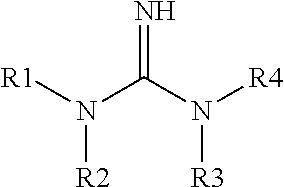Polyol pre-mixes having improved shelf life
- Summary
- Abstract
- Description
- Claims
- Application Information
AI Technical Summary
Benefits of technology
Problems solved by technology
Method used
Image
Examples
example 1
[0115]pH measurement was carried out at ambient temperature using a Metrohm 751 GDP Titrino titrator and an Unitrode Pt1000 (Metrohm part number: 6.0258.000, which is equivalent to Corning #476022) equipped with the temperature compensation function. Standard pH buffer solutions of 4, 7, and 10 purchased from Sigma-Aldrich Co. were used. The calibration was performed daily using the three standard buffer solutions. The slope according to the manufacturer's instruction should be within 0.95 to 1.05; the typical slope obtained is about 0.99 or 1.00. In order to measure apparent pH of a polyol, the procedure of IPA-water method that was described previously was followed. A master batch of isopropanol (HPLC grade purchased from Fischer Scientific) and deionized water solution was prepared using 10 volume parts of isopropanol and 6 volume parts of deionized water. 50 ml of IPA-water solution was dispensed with a 50 ml auto dispenser, and is about 44.4 g. The pH of the 50 ml...
example 2
[0117]In the following examples, foams were made by a hand mix method which is known to people skillful in the art. B-side mixtures were pre-blended and then charged into containers that are suitable for pressure up to 100 psig. Blowing agents were then added into the B-side container and mixed thoroughly. The B-side containers were then placed in an oven that had its temperature controlled at about 50° C. (122° F.). The A-side (MDI) and B-side (mixture of the polyol, surfactant, catalysts, blowing agent, and additives) were mixed with a hand mixer and dispensed into a container to form a free rise foam after storing in a shaker in which the temperature was kept at about 15.6° C. (60° F.). The formulations tested (all had an Iso Index of 110) each contained Rubinate M, a polymeric methylene diphenyl diisocyanate (MDI) available from Huntsman. All polyols were commercially available with desired properties. Tegostab® B 8486 is a surfactant available from Evonik-Degussa. PolyCat® 204 ...
example 3
[0118]Reactivity, gel time (seconds) and tack free time (seconds) were measured at the initial time and then 7 days and 14 days after aging at 50° C. Samples that were aged at 50° C. were weighed after they were removed from the oven to confirm that the loss of component in the B-side was negligible. A and B sides were mixed using an air driven mixer at about 4000 RPM for 5 seconds to ensure the mixing was thorough and foam quality was consistently good. Each formula was repeated at least once, and gel and tack free times were the average of duplicates; the standard deviation was typically about 1 second. The reactivity of the formula in Table 2 is summarized in Table 3-1.
TABLE 3Polyol composition and pH of each componentApparentPolyolPPHPpHPolyether polyol #822.728.59Polyether polyol #122.7210.21Polyester polyol #154.514.74
TABLE 3-1Reactivity (gel and tack free time) ofinitial, and 7 and 14 day aged at 50° C.Reactivity (seconds)Initial7 days14 daysGel time172428Tack free time213238...
PUM
| Property | Measurement | Unit |
|---|---|---|
| Temperature | aaaaa | aaaaa |
| Fraction | aaaaa | aaaaa |
| Time | aaaaa | aaaaa |
Abstract
Description
Claims
Application Information
 Login to View More
Login to View More - R&D
- Intellectual Property
- Life Sciences
- Materials
- Tech Scout
- Unparalleled Data Quality
- Higher Quality Content
- 60% Fewer Hallucinations
Browse by: Latest US Patents, China's latest patents, Technical Efficacy Thesaurus, Application Domain, Technology Topic, Popular Technical Reports.
© 2025 PatSnap. All rights reserved.Legal|Privacy policy|Modern Slavery Act Transparency Statement|Sitemap|About US| Contact US: help@patsnap.com

